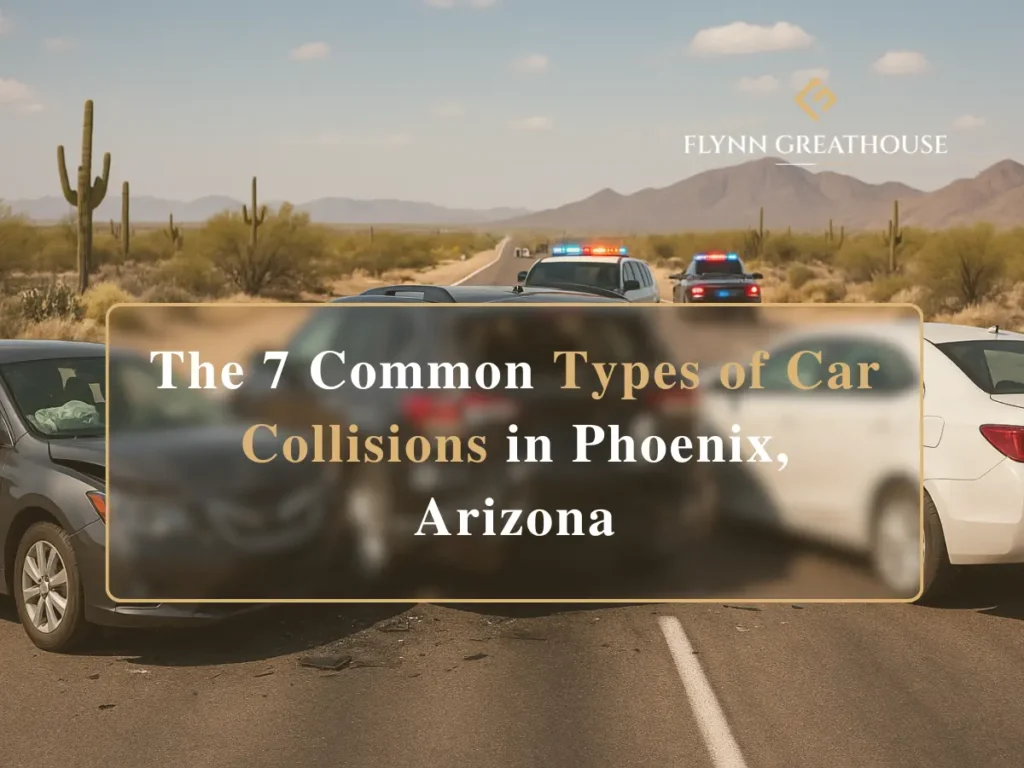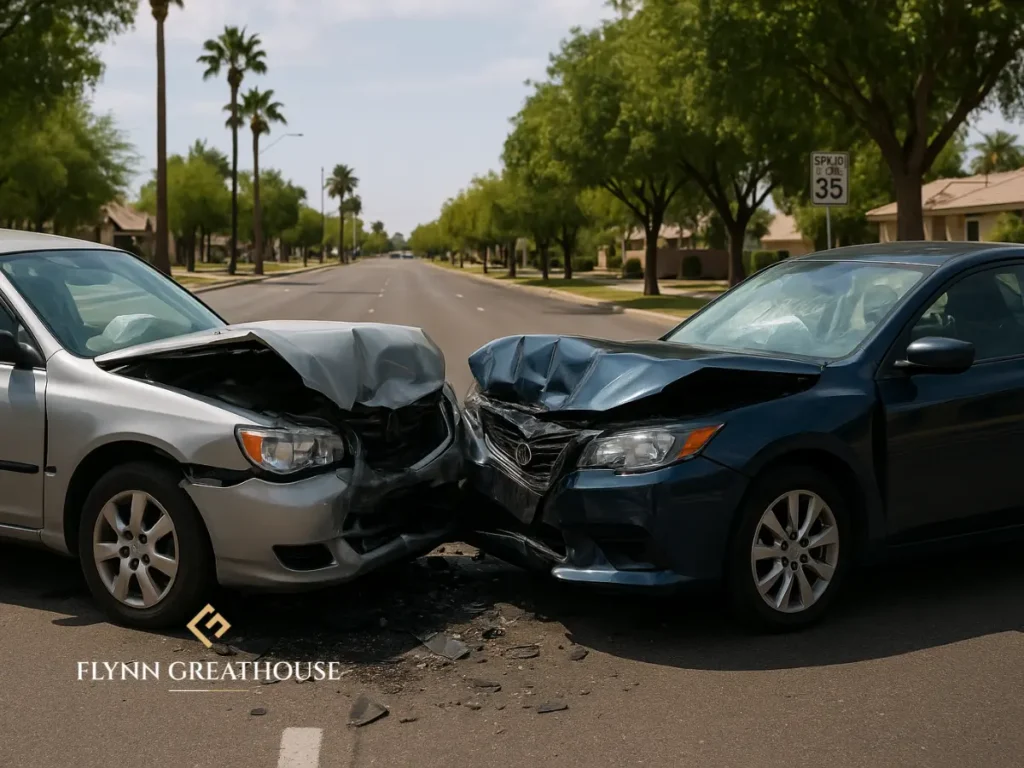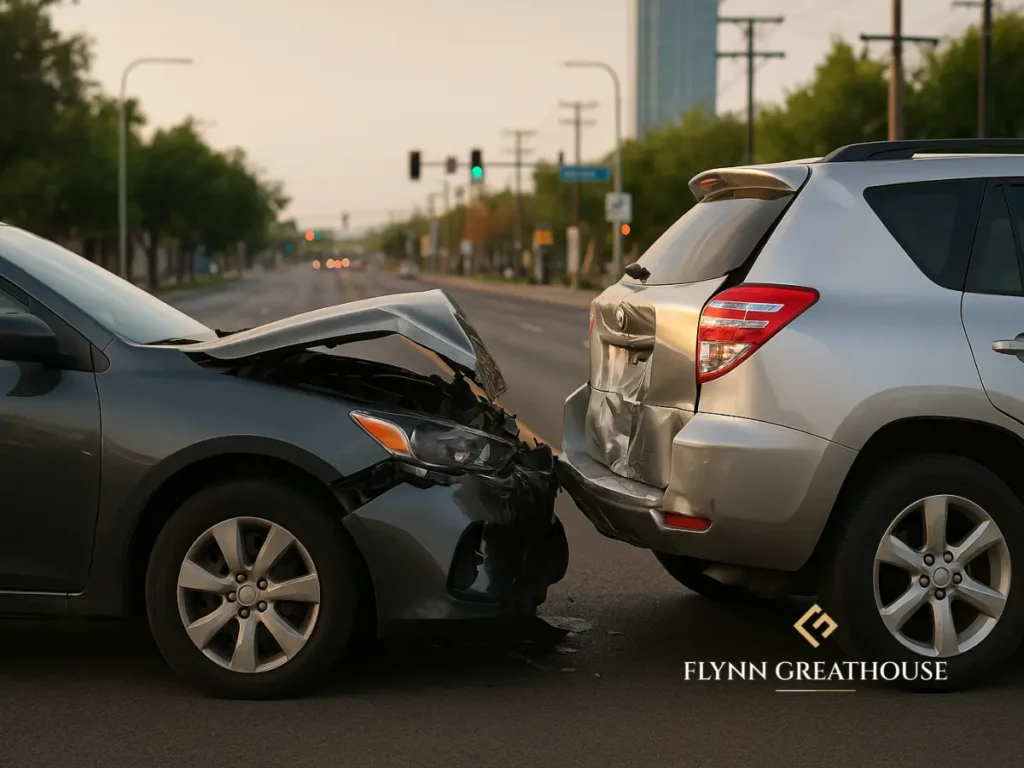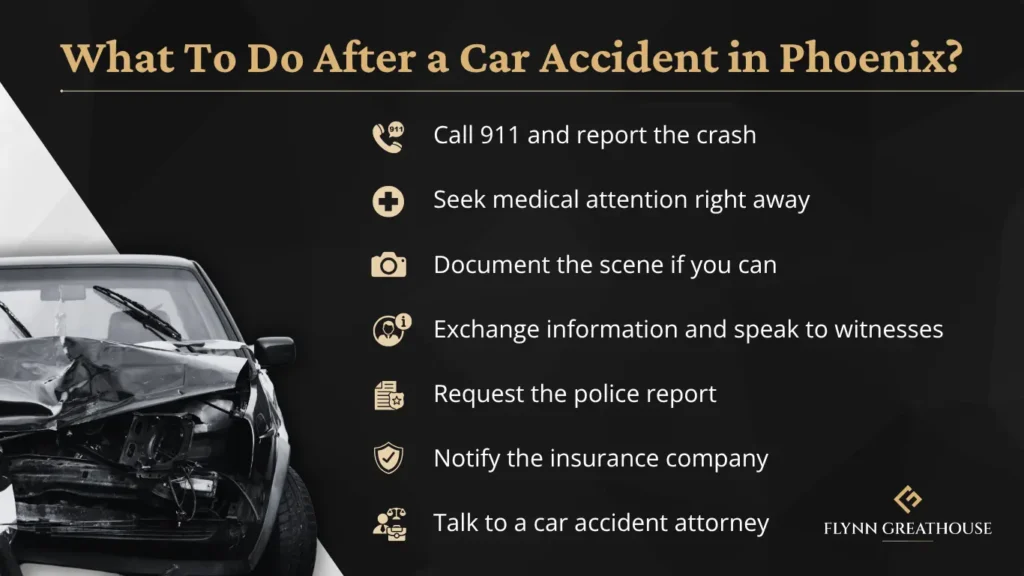
A stretch of desert highway. Three crumpled cars. Police lights flashing against a backdrop of cactus and mountains. It’s the kind of scene you pass by and hope never to be part of until it happens to you.
Getting into a car accident in Phoenix can flip your world upside down. One minute you’re driving to work or picking up your kids. The next, you’re injured, shaken, and wondering how you’re going to deal with medical bills, lost income, and an insurance company that suddenly stops playing nice. It’s a lot. And one thing that often gets overlooked? The type of car crash you were in can shape everything — from how fault is assigned to how much compensation you may be able to recover.
Phoenix has some of the busiest and most dangerous roads in Arizona. From I-10 to Indian School Road, collisions happen every day, and they’re not all the same. In this blog, you’ll learn about the 7 most common types of car collisions in Phoenix, how they happen, and why it matters for your personal injury claim or wrongful death case.

1. Rear-End Collisions
Rear-end crashes are the most frequent type of car accident in Arizona. They usually happen when one driver follows too closely and doesn’t stop in time.
Why They Happen in Phoenix:
- Rush hour stop-and-go traffic on the I-10, I-17, or Loop 202
- Distracted driving (texting, changing playlists)
- Speeding through surface streets like Baseline Road or Bell Road
- Sudden stops at busy intersections like 43rd Avenue and Thomas
Even low-speed rear-end collisions can result in painful injuries. Many victims suffer from:
- Whiplash
- Herniated discs
- Soft tissue injuries
- Concussions
Arizona law generally puts fault on the trailing driver unless there’s clear evidence the front driver acted recklessly. But insurance companies still try to deny or reduce payouts, especially in cases where vehicle damage appears minor.
If you’re in a rear-end crash, it’s important to seek medical attention quickly and document your symptoms. Soft tissue injuries often worsen over time, and the insurance company may claim you weren’t really hurt if you delay treatment.
2. T-Bone Collisions
T-bone or side-impact collisions occur when the front of one car hits the side of another, forming a “T” shape. These are especially common at intersections.
What Causes Them:
- Running red lights or stop signs
- Speeding through yellow lights
- Failing to yield when turning left
- Distracted or impaired driving
Injuries from T-bone crashes tend to be serious, especially for the person sitting on the side of impact. Victims may experience:
- Broken ribs or pelvis
- Internal bleeding
- Head injuries
- Spinal cord trauma
Some of Phoenix’s most dangerous intersections for T-bone crashes include:
- 27th Avenue and Camelback
- 35th Avenue and Thomas Road
- 75th Avenue and Indian School
Insurance companies often dispute fault in these crashes, with both drivers claiming they had the green light. A personal injury attorney can investigate by requesting traffic light sequencing data, surveillance footage, and witness statements.
3. Head-On Collisions

These are among the most dangerous types of crashes. Head-on collisions often result in catastrophic injuries or death due to the force of the impact.
How They Happen:
- A driver crosses the center line on an undivided road
- Someone enters the freeway the wrong way
- Fatigue or drug impairment leads to lane drifting
- Speeding on rural roads outside Phoenix
Injuries from head-on crashes often include:
- Traumatic brain injuries
- Paralysis
- Crushed limbs
- Internal organ damage
If your loved one died in a head-on collision, you may be able to file a wrongful death lawsuit under A.R.S. § 12-611. These claims allow you to seek compensation for funeral costs, loss of financial support, and emotional grief.
4. Sideswipe Collisions
Sideswipe accidents happen when the sides of two vehicles collide while moving in the same direction. These can be deceptively dangerous, especially at highway speeds.
Where They Happen in Phoenix:
- During lane changes on Loop 101 or the 51
- While merging onto SR 143
- On surface roads with tight lanes and heavy traffic
Common causes include:
- Failing to check blind spots
- Drifting between lanes
- Distracted driving
- Aggressive merging
Although initial impact may be light, sideswipes can lead to secondary crashes, especially if one car is pushed into another lane, a barrier, or oncoming traffic. Victims often suffer whiplash, shoulder injuries, and seatbelt-related trauma.
Insurance adjusters may argue that both drivers share fault. If you were injured, your Phoenix injury lawyer may use dashcam footage, accident reconstructions, and expert testimony to help prove the other driver was the one who left their lane.
5. Multi-Vehicle Pileups
Chain-reaction crashes involve three or more vehicles and frequently occur on Phoenix’s busiest roads during rush hour, construction, or low visibility conditions.
Common Triggers:
- A rear-end crash that sets off a chain of impacts
- Drivers tailgating in heavy traffic
- Dust storms or sudden rain reducing visibility
- Speeding and poor reaction time
Pileups are especially common on the I-10 and I-17. These crashes are complicated because:
- Several drivers may be partially at fault
- There are multiple insurance companies involved
- Statements from each driver may conflict
Arizona follows a pure comparative fault system, meaning your compensation can be reduced based on your percentage of fault. That’s why these cases often require thorough investigation, expert analysis, and aggressive legal strategy.

6. Rollover Accidents
A rollover occurs when a car flips onto its side or roof. These crashes are extremely dangerous and often fatal if the vehicle ejects the driver or passengers.
Rollover Risk Factors:
- High center-of-gravity vehicles like SUVs and vans
- Speeding on curves or freeway ramps
- Tire blowouts or poor suspension
- Overcorrecting after drifting off the road
Common Phoenix locations for rollovers include freeway interchanges and suburban roads with sharp curves and narrow shoulders.
Injuries in rollover accidents are often life-altering:
- Neck and spinal cord trauma
- Severe head injuries
- Crushed bones
- Internal bleeding
If the crash was caused by a defective tire or unstable vehicle design, a product liability claim may also be possible. In some cases, poor road maintenance or signage might create legal responsibility for a third party.
7. Hit-and-Run Accidents
Being injured by a driver who flees the scene leaves you with more than just physical damage. It can feel personal, and it adds an extra layer of stress when you’re trying to cover medical bills with no idea who’s responsible.
Where and Why They Happen in Phoenix:
- Late-night collisions near downtown or entertainment districts
- Accidents involving unlicensed or uninsured drivers
- Panic in high-traffic areas or after drug/alcohol use
Under A.R.S. § 28-661, drivers involved in crashes that result in injury or death are legally required to stop and remain at the scene. Leaving is a felony.
If the other driver isn’t found, you can often file a claim under your uninsured motorist (UM) coverage, which may help pay for:
- Hospital and rehabilitation expenses
- Lost wages and future income loss
- Pain, trauma, and emotional suffering
If the hit-and-run driver is later identified, your attorney can file a personal injury lawsuit and pursue damages beyond what your own policy covers.
How the Type of Collision Affects Your Injury Claim

Insurance companies don’t treat every crash the same. Here’s how your type of accident may influence your case:
Rear-End Collisions:
- Adjusters often assume low damage means low injury
- You may need strong medical documentation to validate pain and treatment
T-Bone Crashes:
- Fault is often disputed, especially at intersections
- Traffic camera footage can make or break your claim
Head-On Collisions:
- Often lead to high-dollar claims
- Insurers may investigate aggressively to avoid a full payout
Sideswipes:
- Commonly blamed on both parties
- Evidence of blind spot violations or lane drift becomes key
Multi-Vehicle Pileups:
- Finger-pointing between insurers is common
- A thorough crash reconstruction is often required
Rollover Crashes:
- May involve multiple liable parties (driver, product manufacturer, city)
- Injury severity leads to more pushback on settlement amounts
Hit-and-Run:
- You may be treated with suspicion by your own insurer
- Witnesses, surveillance, and fast reporting can protect your claim
If the insurance company is already giving you the runaround, it’s time to speak with a Phoenix car accident lawyer who can take over the pressure and fight for the compensation you need.

What to Do After a Car Accident in Phoenix
What you do in the minutes and days after a car crash can shape the outcome of your entire case. These aren’t just box-checking steps. They can directly affect how much you’re compensated, how long your claim takes, and whether the insurance company tries to deny responsibility.
Here’s what you should do:
1. Call 911 and Report the Crash
Even if the damage seems minor, call the police. A formal report helps document what happened, who was involved, and what the initial findings were. This record can be critical later, especially if the other driver changes their story.
2. Seek Medical Attention Right Away
Some injuries like concussions, internal bleeding, or whiplash don’t show up immediately. Go to the ER or urgent care, even if you feel “fine.” Medical records from the same day as the crash help show a direct link between your injuries and the accident.
3. Document the Scene if You Can
If you’re physically able and it’s safe to do so:
- Take wide and close-up photos of all vehicles involved
- Photograph skid marks, road debris, nearby signage, and any visible injuries
- Make note of weather, lighting, and traffic conditions
These details can support your case and may reveal evidence that gets lost quickly after the scene is cleared.
4. Exchange Information and Speak to Witnesses
Get the name, contact info, driver’s license number, license plate, and insurance details from all involved drivers. If there are witnesses, ask for their contact information and a brief statement about what they saw. Neutral third-party accounts can carry weight in disputed cases.
5. Request the Police Report
A copy of the crash report can provide valuable details for your claim, including the officer’s notes, driver statements, and any citations issued. Where you request it depends on which agency responded to the scene:
- If the Phoenix Police Department handled the crash, you can request a report through the City of Phoenix Public Records Portal.
- If the Maricopa County Sheriff’s Office (MCSO) responded, you can request an accident report here.
Having the report on file can support your version of events and is often required by insurance companies and attorneys.
6. Notify Your Insurance Company But Be Careful
Let your insurance company know about the crash promptly, but avoid giving a recorded statement until you’ve spoken with a lawyer. Insurance adjusters may try to use your words to reduce or deny your claim. Stick to the facts, and say you’re still assessing injuries and damages.
7. Talk to a Car Accident Attorney Early
You may not feel like you “need” a lawyer right away, especially if the crash seemed minor, but things can change quickly. Injuries may worsen. Insurance delays may start. A Phoenix car accident attorney can step in early, gather evidence, handle the insurance company, and help you pursue the full value of your claim from day one.
Don’t Wait Too Long: Arizona’s Statute of Limitations
In most Arizona car accident cases, you have two years from the date of the crash to file a personal injury or wrongful death lawsuit. That’s under A.R.S. § 12-542.
But here’s the thing:
- Witnesses forget what they saw
- Surveillance footage is often erased within days or weeks
- Vehicle damage may be repaired before it’s fully documented
The sooner you take action, the stronger your case will likely be, and the more options you’ll have. In a lawsuit, your attorney can use the discovery process to demand documents, depose the other driver, and bring in crash reconstruction experts. While most car accident cases still settle out of court, being prepared to litigate often results in stronger settlement offers.
Even if you’re within the time limit, many drivers run into trouble with their claims because they don’t know what to expect. Here’s what Phoenix drivers often miss.
What Phoenix Drivers Often Don’t Know About Auto Accident Claims
Many people assume the insurance company will do the right thing, especially when the other driver was clearly at fault. But here’s what most car accident victims don’t find out until it’s too late:
- Injuries can worsen over time. That soreness today could be a torn ligament tomorrow.
- Your medical records will be scrutinized. Gaps in treatment can be used against you.
- A quick settlement is usually a low settlement. Once you sign, you can’t go back.
- Insurance adjusters are trained to reduce payouts. They may seem friendly, but their job is to protect their company’s bottom line.
A car crash can cause more than just physical damage. It can impact your job, your future medical care, and your overall quality of life. If you’re starting to realize this isn’t a simple claim, don’t wait to get legal guidance.
Here’s a quick checklist to keep on hand if you’re ever involved in a car crash in Phoenix.”

Call a Phoenix Car Accident Law Firm That’s Ready to Work for You
Looking online for “auto accident attorneys near me” or “lawyer for a car accident” will give you a long list of names. But not every law firm focuses exclusively on vehicle-related personal injury cases, and not every firm is ready to take on the insurance companies from day one.
At Flynn Greathouse, this is all we do.
We represent car accident victims in Phoenix and across Arizona, whether you were hurt in a rear-end crash, T-bone, multi-car pileup, hit-and-run, or a serious motorcycle or truck collision. We know Arizona traffic laws, and we know how to deal with insurance companies that try to lowball or delay your claim.
If you’ve been injured in a car accident, take the next step and call (602) 777-3476 now to schedule your free virtual consultation.
At Flynn Greathouse, we’ll handle everything so you can focus on your recovery!
Copyright © 2025. Flynn Greathouse. All rights reserved.
The information in this blog post (“post”) is provided for general informational purposes only and may not reflect the current law in your jurisdiction. No information in this post should be construed as legal advice from the individual author or the law firm, nor is it intended to be a substitute for legal counsel on any subject matter. No reader of this post should act or refrain from acting based on any information included in or accessible through this post without seeking the appropriate legal or other professional advice on the particular facts and circumstances at issue from a lawyer licensed in the recipient’s state, country, or other appropriate licensing jurisdiction.
Flynn Greathouse
2 N Central Ave, Suite 1844
Phoenix, AZ 85004
(602) 777-3476
(888) 823-4249
http://mycaraccidentattorneys.com/

0 Comments